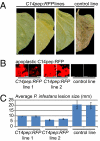Phytophthora infestans effector AVRblb2 prevents secretion of a plant immune protease at the haustorial interface
- PMID: 22143776
- PMCID: PMC3251060
- DOI: 10.1073/pnas.1112708109
Phytophthora infestans effector AVRblb2 prevents secretion of a plant immune protease at the haustorial interface
Abstract
In response to pathogen attack, plant cells secrete antimicrobial molecules at the site of infection. However, how plant pathogens interfere with defense-related focal secretion remains poorly known. Here we show that the host-translocated RXLR-type effector protein AVRblb2 of the Irish potato famine pathogen Phytophthora infestans focally accumulates around haustoria, specialized infection structures that form inside plant cells, and promotes virulence by interfering with the execution of host defenses. AVRblb2 significantly enhances susceptibility of host plants to P. infestans by targeting the host papain-like cysteine protease C14 and specifically preventing its secretion into the apoplast. Plants altered in C14 expression were significantly affected in susceptibility to P. infestans in a manner consistent with a positive role of C14 in plant immunity. Our findings point to a unique counterdefense strategy that plant pathogens use to neutralize secreted host defense proteases. Effectors, such as AVRblb2, can be used as molecular probes to dissect focal immune responses at pathogen penetration sites.
Conflict of interest statement
The authors declare no conflict of interest.
Figures






Similar articles
-
Delivery of cytoplasmic and apoplastic effectors from Phytophthora infestans haustoria by distinct secretion pathways.New Phytol. 2017 Oct;216(1):205-215. doi: 10.1111/nph.14696. Epub 2017 Jul 31. New Phytol. 2017. PMID: 28758684 Free PMC article.
-
The Phytophthora infestans Haustorium Is a Site for Secretion of Diverse Classes of Infection-Associated Proteins.mBio. 2018 Aug 28;9(4):e01216-18. doi: 10.1128/mBio.01216-18. mBio. 2018. PMID: 30154258 Free PMC article.
-
A Recent Expansion of the RXLR Effector Gene Avrblb2 Is Maintained in Global Populations of Phytophthora infestans Indicating Different Contributions to Virulence.Mol Plant Microbe Interact. 2015 Aug;28(8):901-12. doi: 10.1094/MPMI-12-14-0393-R. Epub 2015 Jul 17. Mol Plant Microbe Interact. 2015. PMID: 25894205
-
Effectors of Phytophthora pathogens are powerful weapons for manipulating host immunity.Planta. 2019 Aug;250(2):413-425. doi: 10.1007/s00425-019-03219-x. Epub 2019 Jun 26. Planta. 2019. PMID: 31243548 Review.
-
How do oomycete effectors interfere with plant life?Curr Opin Plant Biol. 2011 Aug;14(4):407-14. doi: 10.1016/j.pbi.2011.05.002. Epub 2011 Jun 9. Curr Opin Plant Biol. 2011. PMID: 21641854 Review.
Cited by
-
Root Endophytism by Pochonia chlamydosporia Affects Defense-Gene Expression in Leaves of Monocot and Dicot Hosts under Multiple Biotic Interactions.Plants (Basel). 2021 Apr 7;10(4):718. doi: 10.3390/plants10040718. Plants (Basel). 2021. PMID: 33917204 Free PMC article.
-
Subfamily-Specific Fluorescent Probes for Cysteine Proteases Display Dynamic Protease Activities during Seed Germination.Plant Physiol. 2015 Aug;168(4):1462-75. doi: 10.1104/pp.114.254466. Epub 2015 Jun 5. Plant Physiol. 2015. PMID: 26048883 Free PMC article.
-
SMAX1-LIKE7 Signals from the Nucleus to Regulate Shoot Development in Arabidopsis via Partially EAR Motif-Independent Mechanisms.Plant Cell. 2016 Jul;28(7):1581-601. doi: 10.1105/tpc.16.00286. Epub 2016 Jun 17. Plant Cell. 2016. PMID: 27317673 Free PMC article.
-
Ten Prominent Host Proteases in Plant-Pathogen Interactions.Int J Mol Sci. 2018 Feb 24;19(2):639. doi: 10.3390/ijms19020639. Int J Mol Sci. 2018. PMID: 29495279 Free PMC article. Review.
-
Disease Resistance Mechanisms in Plants.Genes (Basel). 2018 Jul 4;9(7):339. doi: 10.3390/genes9070339. Genes (Basel). 2018. PMID: 29973557 Free PMC article. Review.
References
Publication types
MeSH terms
Substances
LinkOut - more resources
Full Text Sources
Other Literature Sources

